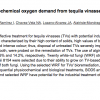
Autores:
Jose Luis Retes-Pruneda
Gustavo Davila-Vazquez
Iliana Medina-Ramírez
Norma Angelica Chavez-Vela
Juan Antonio Lozano-Alvarez
Felipe Alatriste-Mondragon
Juan Jauregui-Rincon
Revista y/o libro:
Environmental Technology
Volumen:
35
Año:
2014
Sinopsis:
The goal of this research is to find a more effective treatment for tequila vinasses (TVs) with potential industrial application in order to comply with the Mexican environmental regulations. TVs are characterized by their high content of solids, high values of biochemical oxygen demand (BOD 5), chemical oxygen demand (COD), low pH and intense colour; thus, disposal of untreated TVs severely impacts the environment. Physicochemical and biological treatments, and a combination of both, were probed on the remediation of TVs. The use of alginate for the physicochemical treatment of TVs reduced BOD 5 and COD values by 70.6% and 14.2%, respectively. Twenty white-rot fungi (WRF) strains were tested in TV-based solid media. Pleurotus ostreatus 7992 and Trametes trogii 8154 were selected due to their ability to grow on TV-based solid media. Ligninolytic enzymes’ production was observed in liquid cultures of both fungi. Using the selected WRF for TVs’ bioremediation, both COD and BOD 5 were reduced by 88.7% and 89.7%, respectively. Applying sequential physicochemical and biological treatments, BOD 5 and COD were reduced by 91.6% and 93.1%, respectively. Results showed that alginate and selected WRF have potential for the industrial treatment of TVs.